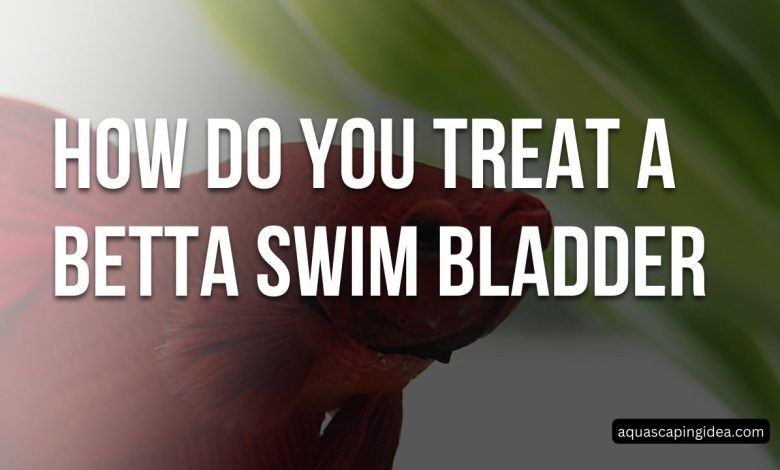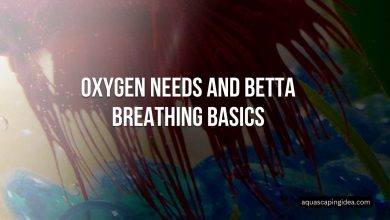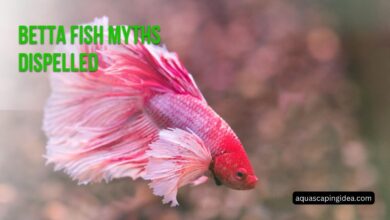How Do You Treat a Betta Swim Bladder?

Like balloons losing lift, what goes up may not come down when our betta’s swim bladder malfunctions. Normally controlling buoyancy via precise air volume regulation, issues with this gas-filled internal organ leave fish struggling sinking or stuck floating.
Managing Betta Swim Bladder Issues
While concerning to spot our flashy friends either nose down and sinking like a deflated balloon or floating up helpless like unsecured party decorations, both scenarios generally yield to appropriate intervention. This article explores the root causes, diagnosis, and remedy options for correcting floaty or grounded bettas distressed by swim bladder problems. Let’s get them properly re-inflated or weighted so they can get back to graceful gliding at preferred depths.
Swim Bladder Function
The swim bladder consists of an air-filled internal sac functioning like a fishy scuba tank sitting just underneath the backbone. Specialized gas gland cells pump or release oxygen and nitrogen to adjust internal pressure and control the fish’s precise vertical position in the water column.
Powered by a complex interplay of gases, nerves, and muscles, this hydrostatic organ works flawlessly—that is until something throws its delicate balance off-kilter. Disruption can leave our poor betta companions either sinking like deflated balloons or floating upwards like untethered parade blimps, unable to easily submerge and participate properly in underwater life.
Causes of Betta Swim Bladder
A variety of issues can interfere with healthy swim bladder inflation and regulation:
Constipation/Blockages – Compacted feces or swallowed tank substrate obstructing the gastrointestinal tract presses upon and deflates the bladder.
Bacterial infections – Pathogens like Aeromonas attack the bladder directly. Inflammation and fluid accumulation interfere with buoyancy regulation.
Gulping air – Aggressive surface feeding causes accidental air ingestion that overinflates the bladder if not burped out.
Fast temperature fluctuations – Dramatic heating or cooling alters internal air pressure faster than the bladder adapts.
Birth defects – Developmental swim bladder abnormalities create lifelong buoyancy challenges.
To effectively treat swim bladder disorders, identifying the specific root cause guides therapeutic decisions. Now let’s explore the hallmark signs of a malfunctioning buoyancy control center.
Symptoms of Betta Swim Bladder
Two primary presentations manifest from swim bladder issues based on whether too little or too much lift remains:
Sinking/Bottom-Sitting Bettas
Deflation of the bladder from blockages, infections, or gas gland dysfunction causes negative buoyancy. Symptoms include:
- Resting on tank bottom and reluctance/inability to swim up
- Tilted nose-down body posture
- Labored breathing from effort to keep swimming upwards
- Loss of appetite from excessive exertion to access surface food
Floating Bettas
Overinflation from gulping air or developmental defects produces buoyancy too positive to readily submerge. Associated signs appear as:
- Resting motionless at water surface due to uncontrolled floating
- Belly tipped upwards as the fish helplessly hovers top-side
- Maintained appetite if food reaches the float-bound fish
Besides the primary challenge controlling depth, secondary issues like starved nutrition, physical injury, opportunistic infections and general lethargy frequently compound either presentation. Prompt diagnosis and appropriate treatment readily relieve most cases before severe sequelae take hold.
Diagnostic Approach
Suspecting a swim bladder disorder based on floating or sinking behavior, recommend diagnostic steps include:
- Inspect overall fish appearance – Note any abnormalities suggesting concurrent health issues.
- Observe swimming attempts and posture – Document exactly how the fish struggles attaining neutral buoyancy.
- Take water measurements – Test oxygenation, pH, contaminants disrupting organ function.
- Rule out intestinal foreign bodies or constipation – Are feces thin? Does the belly feel enlarged?
- Culture to identify pathogenic bacterial infections
Table 1 summarizes the diagnostic testing plan for clarifying the issues plaguing a dysfunctional swim bladder resulting in floating or sinking difficulties:
Table 1. Diagnostic Workup for Swim Bladder Dysfunction
- Physical exam – Morphology, posture, accessory signs
- Swimming capacity evaluation
- Water quality analysis – Oxygenation, pH, nitrogen levels
- Palpation for foreign bodies/feces
- Bacterial culture of bladder wall
Clarifying root causes then directs tailored treatment regimens restoring neutral buoyancy.
Treatment Options
Both sinking and floating disorders secondary to swim bladder conditions benefit from a multi-modal treatment blueprint including:
- Supportive tank adjustments
- Medications
- Diet interventions
- Physical therapy
The specifics within each modality depend on the root diagnosis elicited from a thorough workup. For example, antibiotics combat bacterial infections while laxatives relieve constipation compressing the bladder. Various treatment ingredients formulate into a custom cocktail fitting the betta’s unique needs.
Sinking Causes Appropriate Treatments
Bacterial infections Antibiotics Intestinal impactions Laxatives, hydration Air sac puncture Surface rest, antibiotics Swim exhaustion Supportive hammock, reduced water level
Floating Causes Appropriate Treatments
Surface gulping Reduce feeding aggression
Gas overinflation Fasted days Air sac rupture Antibiotics Congenital defect Long term tank adjustments
While most fish show gradual recovery over days to weeks, persistent or recurrent floating and sinking despite treatment prompts discussion regarding humane euthanasia to prevent drowning, starvation or other complications. Still, bettas exhibit remarkable resilience mastering life’s challenges, often finding ways to thrive in adversity.
Prevention
Preventing swim bladder disease requires modeling an optimally functioning organ system through several buoyancy-supporting strategies:
- Encourage proper digestion – Feed a high quality diet with ideal protein/fat balance. Offer a fasting day weekly. Include blanched veggies to increase digestive efficiency and fiber.
- Limit rapid pressure changes – Perform water changes gradually to allow acclimatization.
- Discourage air gulping – Feed pellets gently one at a time instead of pouring a whole pinch that incites food aggression and hurried swallowing.
- Boost immunity – Address stressors and maintain good water quality.
Following such proactive measures keeps our fish afloat and descending properly through their water column homes. An ounce of prevention is truly worth a pound of cure when supporting betta buoyancy.
FAQs
Do bettas recover from swim bladder problems?
Most cases resolve fully with appropriate treatment matching the root cause. However, congenital issues may persist requiring permanent tank adjustments.
Can a betta live a normal life span with chronic swim bladder problems?
Yes, given adequate owner commitment to long term adaptations facilitating access to food, rest spots, enriched activities despite limited depth control.
Is swim bladder disease painful for bettas?
Secondary complications like injuries, inadequate nutrition and infections severely diminish welfare. Direct bladder dysfunction causes little pain.
Should you fast or feed a bloated betta fish?
Fast for 1-2 days to permit passing obstructing food/feces. Then feed lightly blanched veggies to gradually restart digestion without exacerbating bloat.
Conclusion
Though swim bladder conditions blow our betta friends temporarily off course, correctly diagnosing and addressing the root factors threatening smooth sailing gets them back navigating preferred depths in their aquatic home. Like overfilled party balloons returned to proper buoyancy through careful releases of air, gentle interventions right the balance for our betta companions relying on us to read their signs of distress and respond with effective support. Soon they are trimmed and streaming onward through calmer currents in the tank thanks to righting what floats them or weighs them down. Pay attention and take action for the sake of keeping your bettas centered in their water column world.




